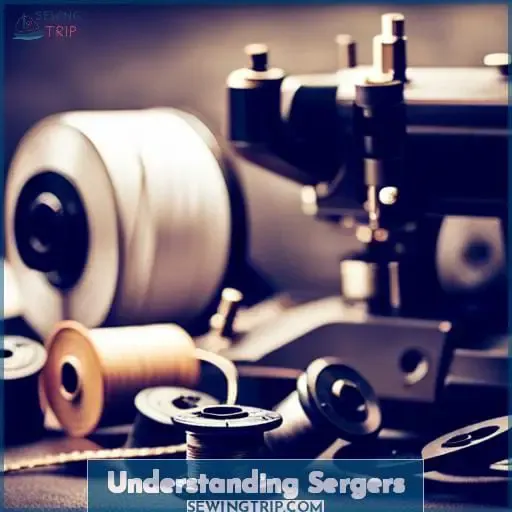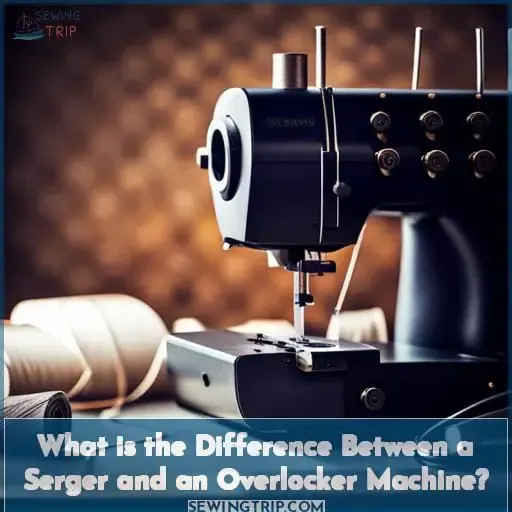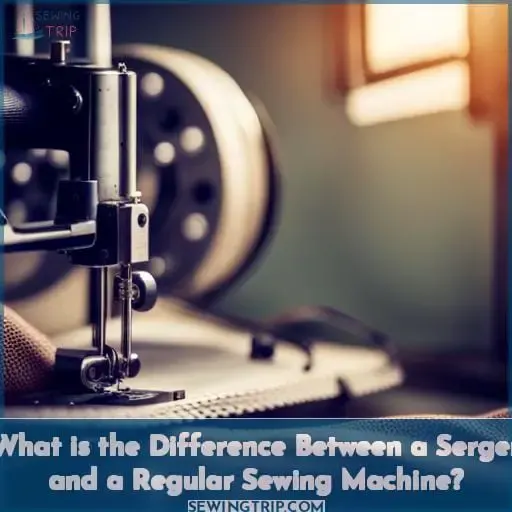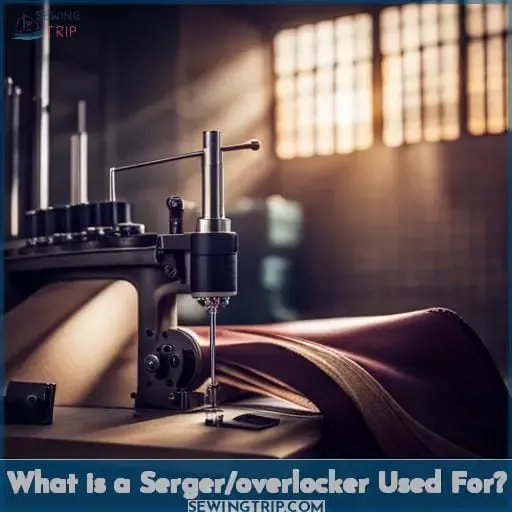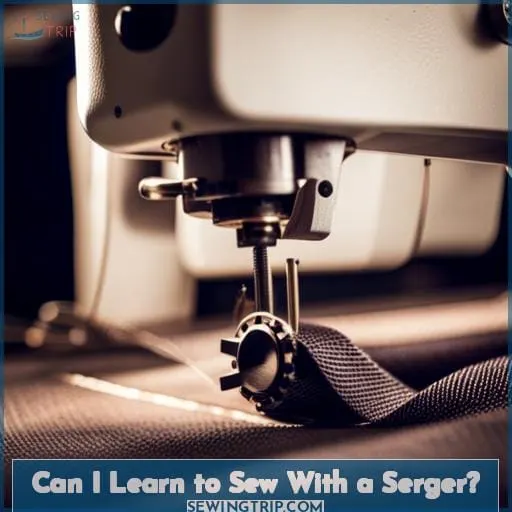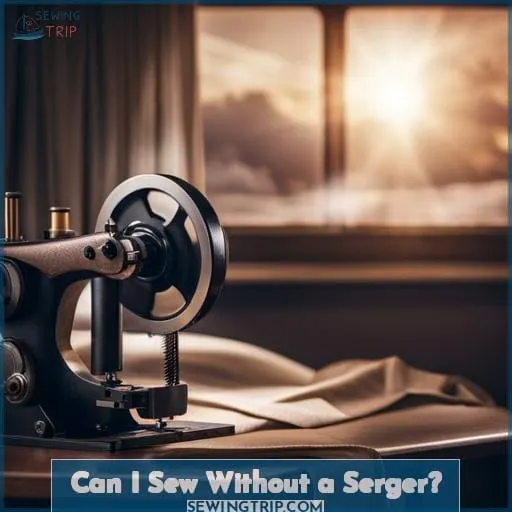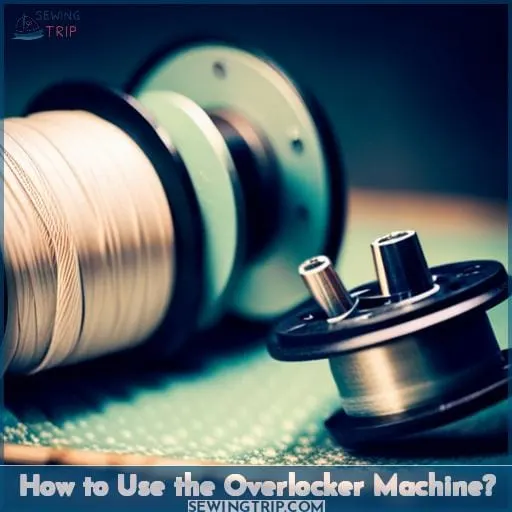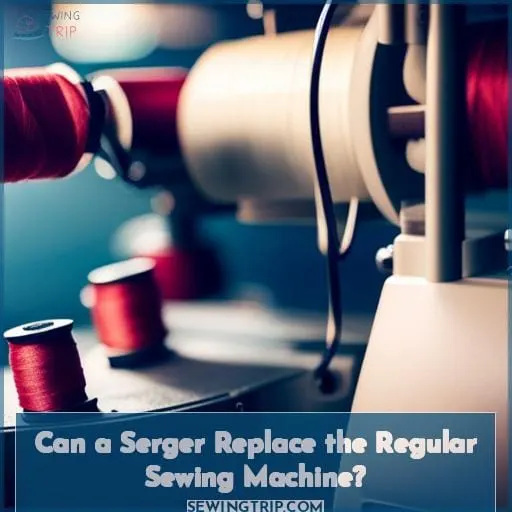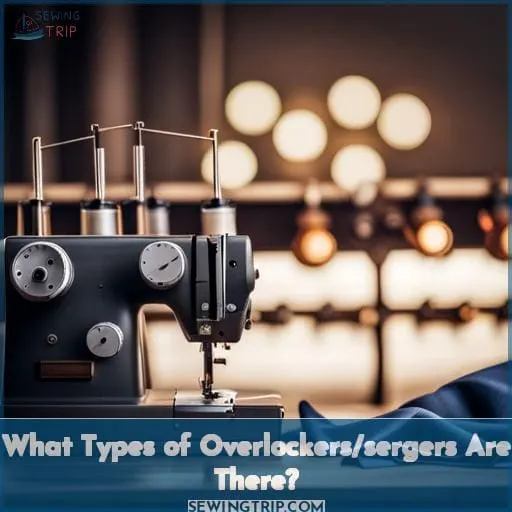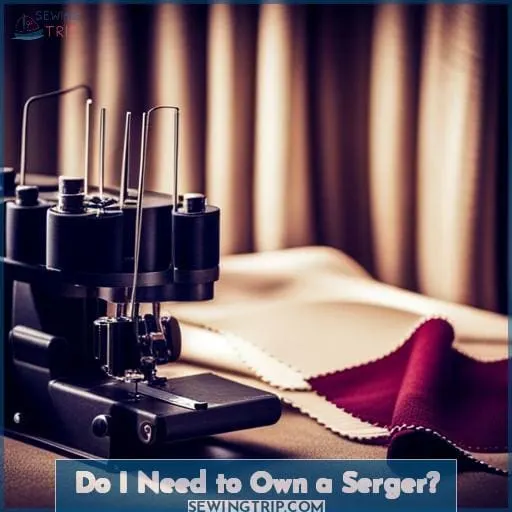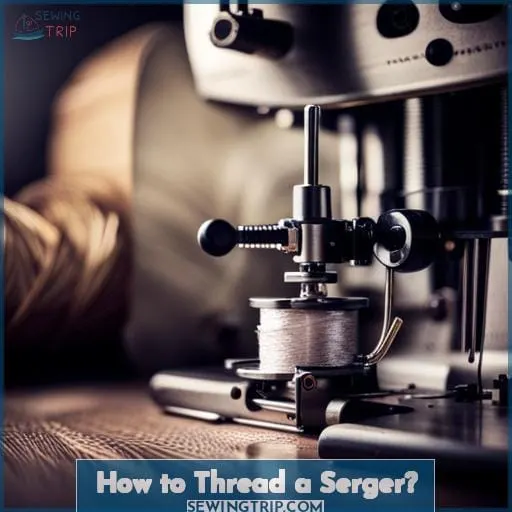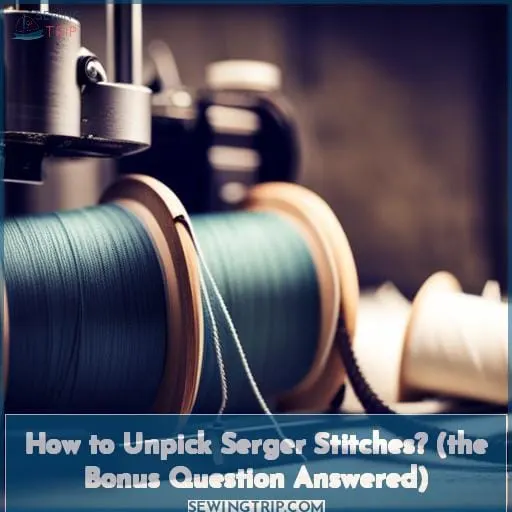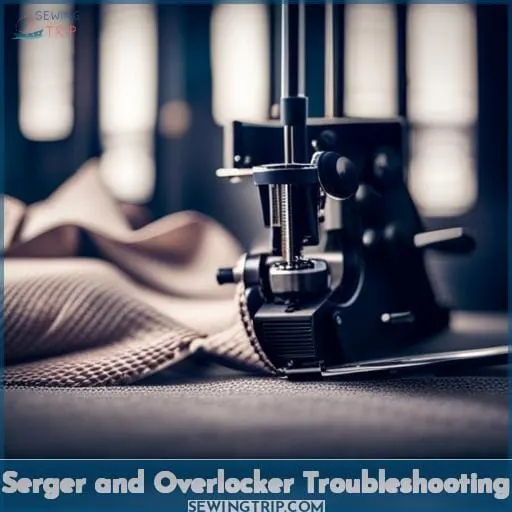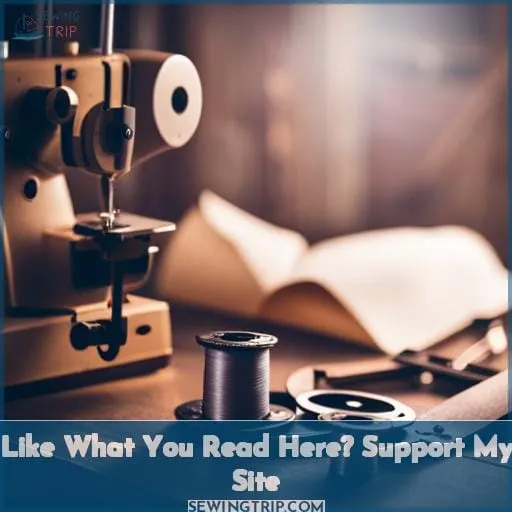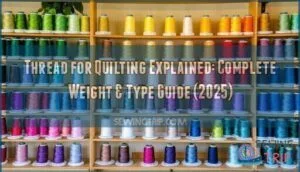This site is supported by our readers. We may earn a commission, at no cost to you, if you purchase through links.
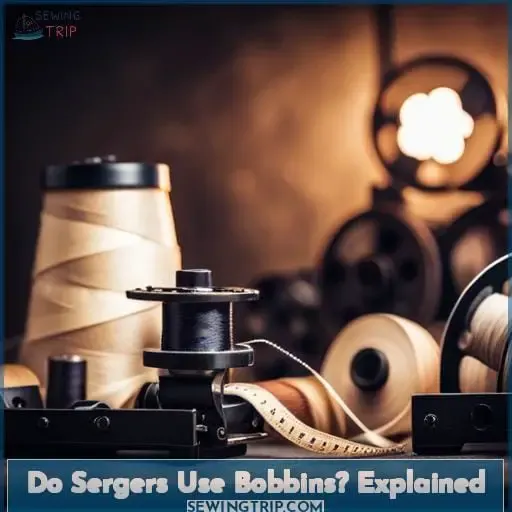 Imagine the feeling of effortlessly creating beautiful, professional-quality stitches with your serger.
Imagine the feeling of effortlessly creating beautiful, professional-quality stitches with your serger.
Now, imagine never having to worry about bobbins again.
In this article, we will dive into the world of sergers and answer that burning question: Do sergers use bobbins?
Get ready to unlock a new level of sewing power and freedom as we explore everything you need to know about using a serger without those pesky bobbins.
So grab your thread cones and let’s get started!
Table Of Contents
- Key Takeaways
- Understanding Sergers
- What is the Difference Between a Serger and an Overlocker Machine?
- What is the Difference Between a Serger and a Regular Sewing Machine?
- What is a Serger/overlocker Used For?
- Can I Learn to Sew With a Serger?
- Can I Sew Without a Serger?
- How to Use the Overlocker Machine?
- Can a Serger Replace the Regular Sewing Machine?
- What Types of Overlockers/sergers Are There?
- Do I Need to Own a Serger?
- Which is the Best Serger Sewing Machine to Buy?
- How to Thread a Serger?
- How to Unpick Serger Stitches? (the Bonus Question Answered)
- Serger and Overlocker Troubleshooting
- Like What You Read Here? Support My Site
- Frequently Asked Questions (FAQs)
- Conclusion
Key Takeaways
- Sergers, also known as overlockers, are sewing machines that combine stitching, trimming excess seam allowance, and overcasting the edge of fabric.
- Unlike regular sewing machines, sergers do not use bobbins.
- Sergers offer advantages such as faster stitching speed, cleaner and more professional-looking seams, and the ability to work with knits and create durable hems.
- In North America, these machines are commonly referred to as sergers, while in Europe and beyond they are known as overlockers.
Understanding Sergers
So you’ve heard about sergers and their amazing capabilities, but maybe you’re not quite sure what they’re or why you need one.
A serger is a sewing machine that combines multiple functions into one simple operation, allowing for professional quality stitching in less time. With the ability to stitch seams, trim excess fabric, and overcast edges all at once, a serger is an essential tool for achieving clean and durable finishes on your sewing projects.
What is a Serger?
Do you know what a serger is?
A serger, also known as an overlocker, is a sewing machine that combines stitching, trimming excess seam allowance, and overcasting the edge of fabric.
Why Do I Need a Serger? Can’t I Just Use My Sewing Machine?
If you’re a sewing enthusiast, you’ll understand the need for a serger in your collection of tools and machines.
- Faster stitching speed
- Cleaner and more professional-looking seams
- Ability to work with knits and create durable hems
Why Are There So Many Threads?
When using a serger, you’ll notice that there are multiple threads going through the machine.
A serger uses several types of lightweight threads in vibrant colors for decorative stitches.
Proper thread storage and handling prevents tangling and breakage, ensuring smooth sewing even at high speeds.
I’m a Little Nervous About the Knives. Are They Safe and Easy to Use?
Commonly, serger knives are safe and straightforward when following guidance.
- Mind placement
- Respect sharpness
- Clean routinely
- Replace dulled
- Follow precautions
The knives cut seam allowances, preventing fraying. Caution provides trouble-free operation.
Will a Serger Replace My Sewing Machine?
After reassuring you about the safety of serger knives, a serger can’t wholly replace your sewing machine because most sewing projects still require basic straight stitches. However, it’s a valuable addition for achieving professional finishes and preventing fabric fraying.
What is the Difference Between a Serger and an Overlocker Machine?
If you’re wondering what sets a serger apart from an overlocker machine, let me explain.
-
Location
- In North America, these machines are usually called sergers, while in Europe and beyond they’re known as overlockers.
-
Threading
- Sergers use loopers instead of bobbins to create stitching. Most have 2-5 threads, while overlockers always use 5.
-
Stitch types
- Sergers focus on overlock stitches to bind edges, while overlockers can also produce coverstitches for hems. Some advanced sergers offer this too.
-
Uses
- Due to the extra threads, overlockers allow for more versatility and decorative techniques in projects. Sergers excel at finishing raw edges quickly on all fabric types.
While these sewing machines have their similarities, the terms aren’t completely interchangeable.
What is the Difference Between a Serger and a Regular Sewing Machine?
Now that you understand the difference between a serger and an overlocker machine, let’s dive into the distinction between a serger and a regular sewing machine. While both machines are used for sewing, they’ve different functions and capabilities.
A regular sewing machine, also known as a lockstitch machine, uses two threads to create stitches. It’s primarily used for basic stitching tasks like hemming, joining fabric pieces together, or adding decorative touches with various stitch patterns.
Regular sewing machines typically have built-in features such as automatic threading and adjustable stitch length.
On the other hand, a serger (or overlock) goes beyond basic stitching by combining multiple thread cones (usually three to five) to create professional-quality seams in one simple operation. Sergers use looper threads instead of bobbins to secure needle thread in place while trimming excess seam allowance and overcasting edges simultaneously.
The main difference lies in their versatility: while regular sewing machines excel at precision work on various fabrics like hems or zippers replacements; sergers specialize in finishing edges quickly without stretching fabric – perfect for knit garments or upholstery projects where durability matters most!
To maintain your investment properly:
- Clean lint from your serger after each project.
- Oil regularly following manufacturer instructions.
- Check tension settings periodically.
- Keep sharp tools away from knives when changing needles
And remember: whether you choose an advanced model with numerous stitch options or stick with something more straightforward depends on how much creativity you want to unleash! You’ll find limitless possibilities using either type of machinery when it comes time for those exciting new projects ahead!
What is a Serger/overlocker Used For?
You use a serger/overlocker for:
- Clean finishing edges of fabric
- Joining seams on knits and stretch wovens
- Rolled hems
- Decorative stitching
A serger trims, stitches, and finishes seams in one step. It uses multiple looper threads instead of a bobbin to lock the stitches. Sergers excel at handling stretch and knit fabrics thanks to features like differential feed.
Compared to a regular sewing machine, a serger sews faster, gives professional results on hems and seams, and handles tricky fabrics. For versatility, maintain your sewing machine for construction and straight stitches.
Use the serger for edges, seams, hems, and embellishing with threads. With practice, it becomes an indispensable tool for garment-sewers.
Can I Learn to Sew With a Serger?
Learning to sew with a serger is definitely achievable and can greatly enhance your sewing skills. Whether you’re a beginner or have experience with a regular sewing machine, the serger opens up new possibilities for creating professional-looking projects.
For beginners, there are sergers specifically designed to be user-friendly and easy to learn. These machines often come with detailed instructions and tutorials that guide you through the process step by step.
Compared to a regular sewing machine, using a serger may require some adjustments in terms of threading and tension settings. However, once you get familiar with these aspects, sewing with a serger becomes straightforward.
One of the advantages of using a serger is its ability to create durable seams that prevent fraying on various types of fabrics.
Additionally, many people find that working on their garment construction or home decor projects becomes faster when using an overlocker due to its high stitching speed compared to traditional machines.
Overall, learning how-to sew effectively utilizing this powerful tool won’t only expand your skillset but also improve the quality and professionalism in all your future creations.
Can I Sew Without a Serger?
If you don’t have a serger, no worries! You can still sew and achieve great results without one.
While a serger offers convenience for finishing edges and seams quickly, it’s by no means essential for sewing.
With some patience and handy tools like pinking shears, a zig zag stitch, or an overcasting foot, you can neatly finish seams and prevent fraying on your regular sewing machine.
Invest time in pressing seams – this alone makes projects look crisp and professional.
Though you’ll sew a bit slower without a serger, take your time and enjoy the process. With care and some clever shortcuts, your projects will meet your standards beautifully.
Focus on acquiring quality fabric, needles, thread, and notions rather than fancy gadgets.
Sew thoughtfully, creatively, and with pride in time-honored techniques. Liberate yourself from dependency on equipment and find freedom in self-sufficiency.
How to Use the Overlocker Machine?
Read the manual to understand each manufacturer’s specific threading sequence, tension adjustments, and other mechanisms before operating your new overlocker.
Here are some general steps to get you started on using your overlocker machine:
- Threading:
Follow the threading guide in your manual to thread each thread cone through its designated path. Make sure to pass the threads through all necessary guides and loopers for proper stitching.
- Tension Adjustments:
Depending on your fabric and desired stitch outcome, adjust the tension settings accordingly using the knobs or dials provided on your machine.
- Other Mechanisms:
Familiarize yourself with any additional features or mechanisms that may be present on your particular model, such as differential feed controls or stitch length adjustments.
Remember that different types of serger threads exist for various purposes; consider factors like weight (50-60), type (polyester/cotton), brand preference (Gutermann/Coats & Clark), and color selection when choosing a suitable serger thread for optimal results in different sewing projects.
Can a Serger Replace the Regular Sewing Machine?
You can definitely sew without a serger, but it can’t fully replace a regular sewing machine. While sergers have their advantages, they serve different purposes than traditional sewing machines.
A serger is primarily used for joining seams and preventing fabrics from fraying, making it perfect for projects with knit fabrics or creating clean edges on woven ones. However, if you need to sew hems, curtains, or replace zippers on garments and home decor items, a regular sewing machine is still necessary.
A serger’s specialized functions make it an excellent tool for certain tasks like finishing the edges of fabric pieces or creating durable seams in knits. It offers speed and efficiency that allows you to achieve professional-looking results in less time compared to using just a regular sewing machine alone.
For beginners who are just starting out with their sewing journey at home and want versatility in their projects beyond basic stitching needs like straight stitches or zigzag stitches commonly found on most standard machines – having both tools will give them more options as they learn new techniques along the way rather than limiting themselves by relying solely on one type of equipment.
To ensure your serger performs optimally over time consider proper maintenance such as regularly cleaning lint build-up from its parts (especially around thread tension discs) after each use; oiling specific areas per manufacturer instructions before first use may be required too depending upon model specifications; adjusting tensions based upon fabric thicknesses being worked with so stitch quality remains consistent throughout various types/materials being handled – these steps help prolong service life while maintaining optimal performance levels overall which ultimately translates into better user experiences when operating said devices even under heavy workloads common among avid users performing multiple garment-making tasks concurrently (e.
In summary:
While there are some similarities between a serger and traditional sewing machine functionality-wise since both share capabilities related specifically towards producing decorative edge finishes/overcasting procedures within stitched material assemblies during construction processes typically associated with garments/textiles creations, they each have their unique features that make them indispensable in different scenarios.
A serger can enhance the quality and efficiency of your sewing projects, but it can’t replace the versatility and range of stitching options provided by a regular sewing machine.
What Types of Overlockers/sergers Are There?
Now that you understand the versatility of a serger and how it can enhance your sewing projects, let’s explore the different types of overlockers/sergers available to suit your specific needs.
-
Brother Serger DZ1234 Metal Frame Overlock Machine:
- This adjustable 3-4 thread serger offers a metal frame for durability and stitch width from 3 to 7mm.
- With up to 1300 stitches per minute speed, easy threading guides, three presser feet, starter thread, and manual included.
-
Yamata High Speed Industrial Serger Overlock:
- If you’re looking for an industrial-grade option with exceptional speed (up to 7500 stitches per minute), this electric sewing machine is perfect for light and medium materials.
- It features auto-lubrication, adjustable tension for neat stitching at high speeds (assembly required).
-
JUKI MO654DE Portable Thread Serger Sewing Machine:
- Ideal for versatile performance on light to heavy fabrics with its easy threading system and color-coded guides; it delivers professional-quality finished seams at a max speed of 1500 stitches per minute.
-
Singer Professional Serger Overlock Stitch Capability:
- Offering excellent versatility with its ability to handle two-to-five threads while achieving speeds up to1300 stitches-per-minute; ideal choice when needing seams or hems on edges rolled hemming & more!
These machines come equipped with various features such as differential feed control (to prevent stretching or gathering), self-adjusting tension systems(ensuring even stitching across fabric layers), automatic rolled hem settings(for seamless finishing touches).
By choosing the right type of overlocker/serge machine tailored specifically towards your unique sewing requirements & preferences – success in achieving beautiful professional results becomes effortlessly within reach!
Do I Need to Own a Serger?
If you’re serious about taking your sewing skills to the next level and achieving professional-quality finishes, owning a serger is highly recommended.
| Advantages of Owning a Serger |
|---|
| Professional-Quality Finishes |
| Fast and Efficient Sewing |
| Versatile Stitch Options |
A serger allows you to achieve professional-quality finishes on your garments and other projects.
In terms of speed, sewers often find that using a serger speeds up their workflow significantly compared to using just their regular sewing machine.
Additionally, the different stitch options available on most serge machines offer versatility in creating various types of seams and decorative effects.
Furthermore, if you enjoy working with knits or fabrics prone to fraying edges such as chiffon or silk satin for example), having access to an overlocker will make it easier for you when dealing with these materials.
While not absolutely necessary for beginners starting out in the world of garment construction or craft making; however once experienced users get taste liberation from power gained through understanding how beneficial investing into proper equipment like this one can be they’ll never look back!
Which is the Best Serger Sewing Machine to Buy?
Looking to invest in a serger sewing machine? Let me introduce you to three top contenders:
- The Brother Serger DZ1234 Metal Frame Overlock Machine
- The Yamata High Speed Industrial Serger Overlock
- The JUKI MO654DE Portable Thread Serger Sewing Machine
Each of these machines offers unique features such as adjustable stitch width, high-speed stitching capabilities, easy threading guides, and versatile performance for various fabric weights. Whether you’re a sewing machine repair technician or a garment instructor looking for the best options to recommend to your clients or students, these sergers are worth considering.
Brother Serger DZ1234 Metal Frame Overlock Machine
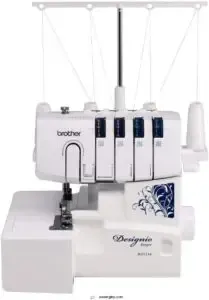
The Brother Serger DZ1234 Metal Frame Overlock Machine is one of the top contenders when it comes to finding the best serger sewing machine for your needs. With its metal frame, adjustable stitch width, and impressive speed of 1,300 stitches per minute, this serger offers reliability and versatility.
It also includes color-coded thread guides and numbered upper and lower thread loopers for easy use. The accessory feet that come with it allow you to explore different stitching techniques right away.
However, beginners may find it intimidating at first, and the manual is only available in English.
- Metal frame provides durability
- Adjustable stitch width allows for customization
- High stitching speed saves time
- May be overwhelming for beginners
- Manual only available in English
Yamata High Speed Industrial Serger Overlock
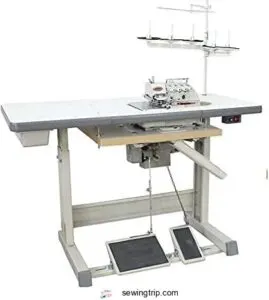
You should consider the Yamata High Speed Industrial Serger Overlock as one of the best serger sewing machines to buy.
This powerful machine offers a maximum sewing speed of 7500 stitches per minute, making it perfect for light and medium-weight materials. With low sewing tension and auto lubrication, you can achieve neat and beautiful stitches even at high speeds.
The Yamata High Speed Industrial Serger Overlock is designed for productivity and delivers stable sewing finishes.
- Maximum sewing speed of 7500 stitches per minute
- Suitable for light to medium-weight materials
- Neat and beautiful stitch quality
- Professional assembly required
- Limited warranty (head: 6 months; motor: 1 year)
JUKI MO654DE Portable Thread Serger Sewing Machine
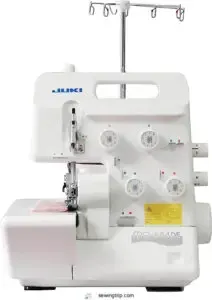
When considering the best serger sewing machine to buy, you can’t go wrong with the JUKI MO654DE Portable Thread Serger Sewing Machine. This fast and reliable 2/3/4 thread serger offers versatile performance for sewing light to heavy weight fabrics.
With easy threading, color coded guides, differential feed, and a maximum speed of 1500 stitches per minute, you can achieve professional-quality finished seams for apparel and home décor projects.
However, beginners may find threading tricky initially and some users have reported problems with the bobbin winder.
- Fast and reliable stitching
- Versatile performance on various fabric weights
- Automatic rolled hem feature
- Tricky threading for beginners
- Bobbin winder issues reported by some users
How to Thread a Serger?
To start threading your serger, begin by ensuring that you have followed the manufacturer’s instructions for setup and preparation.
Threading a serger can seem daunting at first, but with practice and patience, it will become second nature.
- Start by raising the presser foot to release tension on the threads.
- Begin with the upper looper thread. Follow the color-coded guide or use a threading diagram specific to your machine model.
- Next, thread the lower looper using another color-coded guide or diagram.
- Finally, thread each needle individually according to their corresponding guides.
Remember to always check that there’s no tension on any of these threads before starting sewing.
Threading a serger requires attention to detail and precision. Take care not only when threading but also in maintaining proper tension throughout all stages of operation. Regular cleaning and oiling will help keep your machine running smoothly for years of reliable service.
How to Unpick Serger Stitches? (the Bonus Question Answered)
Unpicking serger stitches takes patience and the right tools, but here’s how to do it safely and efficiently:
- Use sharp, pointed tweezers and small scissors. The dense, tight stitches require precision tools to grab and snip individual threads.
- Identify seam components. Serged seams involve several interlocking threads, so isolate each section systematically.
- Work in small sections. Attempting long lengths of stitching at once leads to frustration.
As for bobbins – sergers differ from conventional lockstitch machines. Instead of bobbins, loopers on sergers carry the lower threads to interlock with needle threads for seams. Each serger has a specific number and type of loopers. Check manuals to select threads suiting your machine’s tension, fabrics and stitches for optimal performance.
Proper maintenance like regular oiling also prevents frustrating tangles or breaks. Adjust presser foot pressure and stitch length/width settings until decorative stitch types like rolled hems feed smoothly.
Above all, never bypass safety guards, and take care around blades while threading, sewing and cleaning sergers.
Serger and Overlocker Troubleshooting
Troubleshooting your serger involves carefully examining each component and making methodical adjustments until you’ve solved the problem. When it comes to bobbin-related issues, keep in mind that sergers don’t use bobbins like regular sewing machines do.
Instead, they utilize loopers to create stitches and secure the threads in place. However, there are other common troubleshooting areas to consider when experiencing difficulties with your serger.
Table: Common Serger Troubleshooting Tips
| Problem | Possible Solution |
|---|---|
| Uneven Stitching or Skipped Stitches | Check thread tension settings and adjust accordingly. Ensure that all threads are properly threaded through their respective guides and tensions discs. |
| Breaking Threads | Examine needle condition for any signs of damage or dullness; replace if necessary. Make sure the needles are inserted correctly (flat side facing back). Adjust tension settings as needed. |
| Fabric Puckering | Ensure differential feed is set appropriately for fabric type (higher number for stretchy fabrics, lower number for woven fabrics). Consider using a stabilizer under lightweight materials. |
| Stitch Misalignment | Re-thread entire machine following proper threading sequence outlined in manual; ensure correct color-coding of threads on tension dials. |
By addressing these potential issues related to thread tension, needle condition, differential feed adjustment,and proper threading techniques,you can troubleshoot many common problems with yourserger.
Ensuring smooth operationand optimal stitch qualitywill help unleashyour creative poweras youexplorethe possibilitiesof this versatilemachine.The keyisto be patient,take timefor careful examination,andmakeadjustments systematicallyuntilyou achieve desired results.
Like What You Read Here? Support My Site
If you enjoyed reading this article and found the information helpful, please consider supporting my site.
As a sewing machine repair technician, sewing/garment instructor, and sewing machine dealer, I strive to provide valuable content that empowers you in your sewing endeavors. By supporting my site, you aren’t only helping me continue to create informative articles like this one but also contributing to the growth of our vibrant community of sewists.
Here are three reasons why supporting my site is beneficial:
- Access to Exclusive Content:
By becoming a supporter or subscriber, you’ll gain access to exclusive tutorials and resources that will further enhance your skills as a sewer.
- Personalized Assistance:
As a supporter or subscriber, you can reach out directly with any questions or concerns regarding serger thread for embroidery , serger vs coverstitch , serger machine maintenance , serger for beginners ,serger foot pressure.
- Community Engagement:
Joining our supportive community allows us all to connect with fellow sewists who share similar interests and passions.
Your support means everything! Together we can foster an environment where creativity thrives and knowledge is shared freely among passionate individuals like yourself.
Frequently Asked Questions (FAQs)
What types of fabrics work best with a serger?
Knits, lightweight wovens, and stretch fabrics work best with a serger.
The exceptional durability and flexibility of serger seams tolerate intensive handling and stretching.
Use sergers for knits, lingerie, athletic wear, soft furnishings, and children’s clothing.
How do I clean lint and threads out of my serger?
Regularly clean lint and threads from your serger.
Wipe down the throat plate, feed dogs, tension discs, loopers, upper knife, and lower knife using a small brush.
Remove threads wound on moving parts with tweezers.
Always unplug machine first for safety.
An occasional oiling keeps components running smoothly too.
What accessories are useful to have for a serger?
To achieve professional results with your serger, consider investing in useful accessories like:
- Extra needles
- Thread cones in various colors
- A lint brush for maintenance
- Specialty presser feet
These additions will enhance your sewing experience and empower you to create stunning garments.
How do I adjust the tension on a serger?
To adjust the tension on your serger, locate the tension dials or knobs.
Turn them clockwise to increase tension and counterclockwise to decrease it.
Experiment with different settings until you achieve balanced stitches for a professional finish.
What maintenance does a serger need?
Stay on top of regular cleaning and oiling to keep your serger running smoothly for years to come. This allows full functionality so you can unleash your creative potential through sewing.
Conclusion
To sum it up, sergers don’t use bobbins.
With a serger, you can effortlessly create professional-quality stitches without the hassle of bobbin changes.
Sergers are a valuable tool for sewing enthusiasts and professionals alike, offering speed, precision, and versatility.
Whether you’re a beginner learning to sew or an experienced seamstress looking to enhance your skills, a serger can greatly enhance your sewing projects.
So say goodbye to bobbins and unlock a new level of sewing power with a serger.

